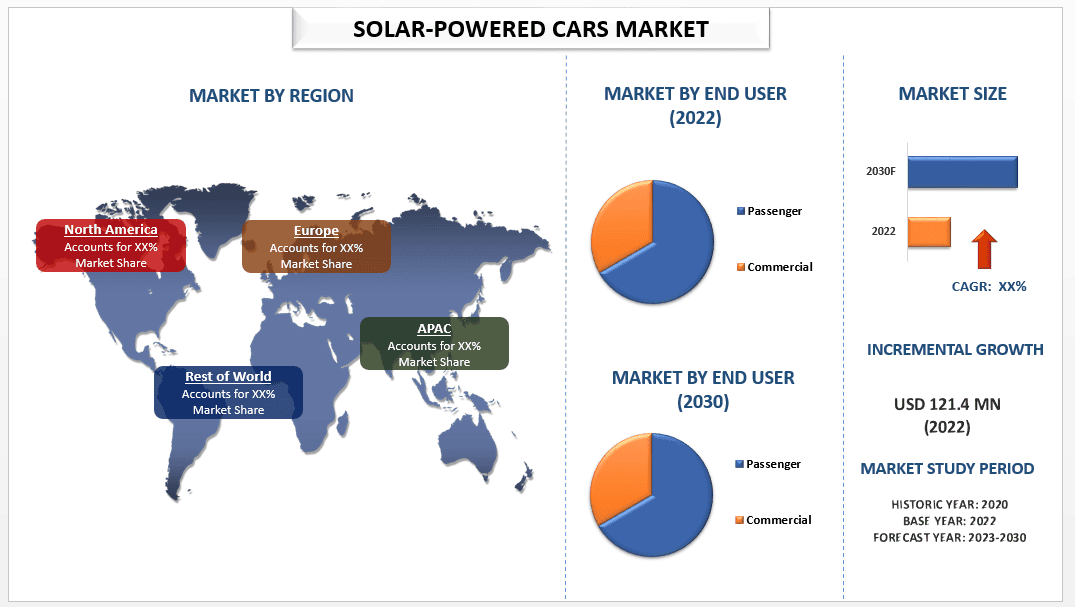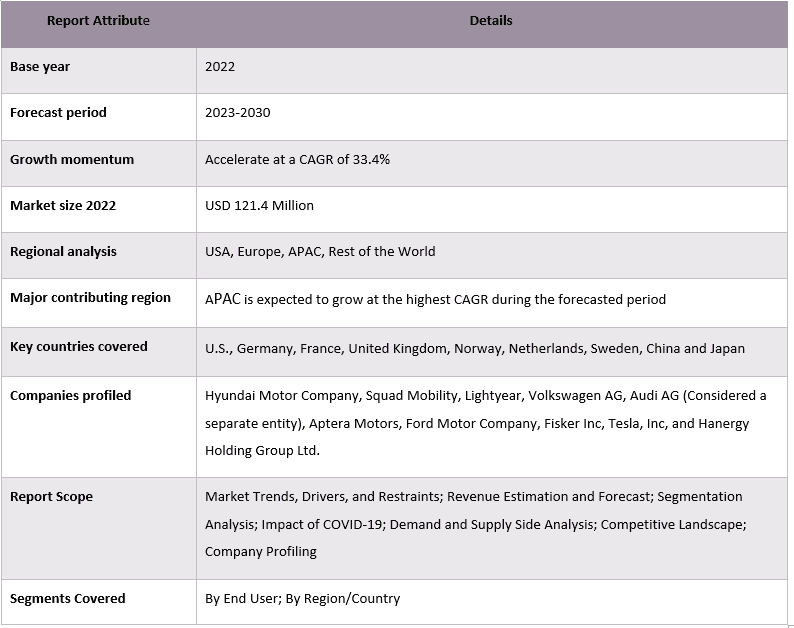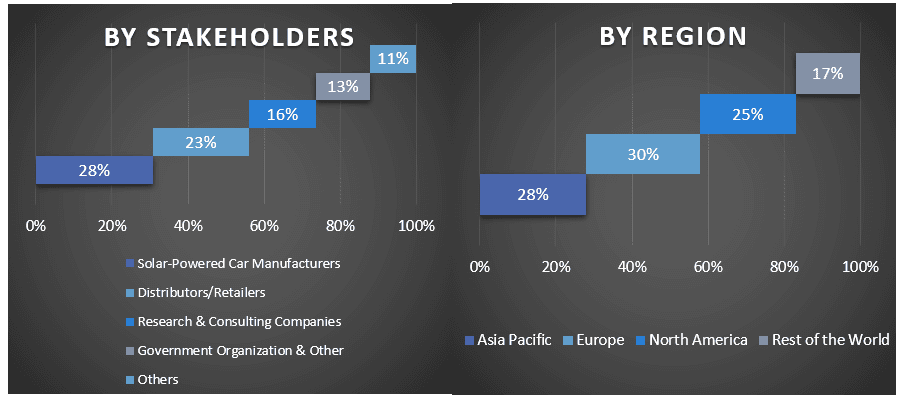- Home
- Chi siamo
- Settore
- Servizi
- Lettura
- Contattaci
Mercato delle auto ad energia solare: analisi attuale e previsioni (2023-2030)
Importanza dell'utente finale (residenziale e commerciale) e regione/paese

Si prevede che il mercato delle auto a energia solare crescerà a un forte CAGR del 33,4% durante il periodo di previsione. Ciò è dovuto principalmente ai programmi e agli incentivi governativi per promuovere un'energia rinnovabile più pulita e alla crescente domanda di prodotti solari da parte dei consumatori sul mercato. Molte aziende automobilistiche affermate come Hyundai Motor Company, Volkswagen, Audi, Ford Motor e Tesla hanno iniziato a fare ricerca sulle auto a energia solare e hanno pianificato modelli prototipo che le aziende intendono introdurre entro il prossimo anno. Sono state fondate anche nuove aziende automobilistiche come Lightyear, Aptera Motors e Squad Mobility dopo aver visto la domanda e il potenziale delle auto a energia solare sul mercato.
Anche le aziende di pannelli solari come Hanergy hanno introdotto la loro versione di auto a energia solare, che include pannelli solari a film sottile per caricare l'automobile. La domanda di auto a energia solare è in forte espansione nonostante tali auto non siano ancora prontamente disponibili. Lightyear 2 (un prodotto di Lightyear) ha oltre 40.000 prenotazioni da singoli acquirenti e circa 20.000 preordini da proprietari di flotte come società internazionali di leasing e car-sharing LeasePlan, MyWheels, Arval e Athlon. La società non ha nemmeno rilasciato molte informazioni sull'auto e la produzione dovrebbe iniziare entro il 2025.
Alcuni dei principali operatori che operano sul mercato sono Hyundai Motor Company, Squad Mobility, Lightyear, Volkswagen AG, Audi AG (considerata un'entità separata), Aptera Motors, Ford Motor Company, Fisker Inc, Tesla, Inc e Hanergy Holding Group Ltd.
Diverse fusioni e acquisizioni insieme a partnership sono state intraprese da questi attori per facilitare i clienti con prodotti/tecnologie hi-tech e innovativi.
Approfondimenti presentati nel rapporto
"Tra gli utenti finali, il segmento dei passeggeri deteneva una quota dominante del mercato nel 2022"
Sulla base dell'utente finale, il mercato delle auto a energia solare è diviso in segmenti residenziali e commerciali. Il segmento dei passeggeri ha acquisito una quota di maggioranza nel mercato delle auto a energia solare e si prevede che mostrerà un tasso di crescita sostanziale durante il periodo di previsione. Si prevede che il segmento commerciale sarà un grande segmento in futuro; tuttavia, la mancanza di efficienza di conversione dell'energia è la sfida più grande a causa della crescita limitata nel segmento commerciale insieme all'alto prezzo del veicolo. La maggior parte dei veicoli venduti ora utilizza solo pannelli solari per caricare segmenti supplementari del veicolo come il sistema di ventilazione, tuttavia, si prevede che il lancio di veicoli commerciali a energia solare cambierà il mercato nei prossimi anni.
Copertura del rapporto sul mercato delle auto a energia solare

"L'APAC ha dominato il mercato delle auto a energia solare nel 2022"
L'APAC ha registrato la quota di mercato più alta nel mercato delle auto a energia solare e si prevede che assisterà a un CAGR influente nel periodo previsto. Ciò è dovuto principalmente a molti progetti di auto a energia solare che si svolgono in Cina, Corea del Sud e Giappone. Inoltre, le politiche, i regolamenti e gli investimenti governativi favorevoli per raggiungere gli obiettivi di energia rinnovabile stabiliti da vari paesi stanno guidando il mercato. Ad esempio: in Australia, il governo australiano fornirà 14 milioni di AUD per sostenere il progetto strategico di innovazione tecnologica di 5B da 33,4 milioni di AUD attraverso l'Australian Renewable Energy Agency; In Giappone, il governo giapponese ha stanziato 8 miliardi di yen nel bilancio nazionale 2021 per sostenere l'introduzione di apparecchiature autonome per la generazione di energia solare e batterie di accumulo, compresi i veicoli elettrici, attraverso PPA in loco; e in India, il governo indiano ha annunciato un'ulteriore infusione di capitale di Rs. 10 miliardi alla Solar Energy Corporation of India e Rs. 15 miliardi all'Indian Renewable Energy Development Agency. Un aumento nel settore dell'energia solare fungerà da catalizzatore nella crescita del mercato delle auto a energia solare durante il periodo di previsione.
Motivi per acquistare questo rapporto:
- Lo studio include l'analisi delle dimensioni del mercato e delle previsioni convalidate da esperti chiave del settore autenticati.
- Il rapporto presenta una rapida panoramica delle prestazioni complessive del settore a colpo d'occhio.
- Il rapporto copre un'analisi approfondita dei principali peer del settore con un focus primario sui principali dati finanziari aziendali, portafogli di prodotti, strategie di espansione e sviluppi recenti.
- Esame dettagliato dei fattori trainanti, dei vincoli, delle tendenze chiave e delle opportunità prevalenti nel settore.
- Lo studio copre in modo completo il mercato in diversi segmenti.
- Analisi approfondita a livello regionale del settore.
Opzioni di personalizzazione:
Il mercato globale delle auto a energia solare può essere ulteriormente personalizzato in base alle esigenze o a qualsiasi altro segmento di mercato. Oltre a questo, UMI comprende che potresti avere le tue esigenze aziendali, quindi sentiti libero di metterti in contatto con noi per ottenere un rapporto che si adatti completamente alle tue esigenze.
Indice
Metodologia di ricerca per l'analisi del mercato delle auto a energia solare (2022-2030)
L'analisi dello storico del mercato, la stima del mercato attuale e la previsione del mercato futuro del mercato globale delle auto a energia solare sono stati i tre principali passaggi intrapresi per creare e analizzare l'adozione di auto a energia solare nelle principali regioni a livello globale. È stata condotta un'approfondita ricerca secondaria per raccogliere i dati storici del mercato e stimare le dimensioni del mercato attuale. In secondo luogo, per convalidare queste intuizioni, sono state prese in considerazione numerose scoperte e ipotesi. Inoltre, sono state condotte anche interviste primarie approfondite con esperti del settore lungo tutta la catena del valore del mercato globale delle auto a energia solare. Dopo l'assunzione e la convalida dei dati di mercato attraverso interviste primarie, abbiamo impiegato un approccio top-down/bottom-up per prevedere le dimensioni complete del mercato. Successivamente, sono stati adottati metodi di suddivisione del mercato e triangolazione dei dati per stimare e analizzare le dimensioni del mercato dei segmenti e dei sottosegmenti pertinenti al settore. La metodologia dettagliata è spiegata di seguito:
Analisi delle dimensioni storiche del mercato
Passaggio 1: Studio approfondito delle fonti secondarie:
È stato condotto uno studio secondario dettagliato per ottenere le dimensioni storiche del mercato delle auto a energia solare attraverso fonti interne aziendali come relazioni annuali e bilanci, presentazioni sulle performance, comunicati stampa, ecc., e fonti esterne tra cui riviste, notizie e articoli, pubblicazioni governative, pubblicazioni della concorrenza, rapporti di settore, database di terze parti e altre pubblicazioni credibili.
Passaggio 2: Segmentazione del mercato:
Dopo aver ottenuto le dimensioni storiche del mercato delle auto a energia solare, abbiamo condotto un'analisi secondaria dettagliata per raccogliere informazioni storiche sul mercato e quote per diversi segmenti e sottosegmenti per le principali regioni. I principali segmenti sono inclusi nel rapporto come Utente Finale. Sono state condotte ulteriori analisi a livello di paese per valutare l'adozione complessiva di modelli di test in quella regione.
Passaggio 3: Analisi dei fattori:
Dopo aver acquisito le dimensioni storiche del mercato di diversi segmenti e sottosegmenti, abbiamo condotto una dettagliata analisi dei fattori per stimare le dimensioni attuali del mercato delle auto a energia solare. Inoltre, abbiamo condotto un'analisi dei fattori utilizzando variabili dipendenti e indipendenti come l'Utente Finale del mercato delle auto a energia solare. È stata condotta un'analisi approfondita per gli scenari di domanda e offerta considerando le principali partnership, fusioni e acquisizioni, espansione aziendale e lanci di prodotti nel settore del mercato delle auto a energia solare in tutto il mondo.
Stima e previsione delle dimensioni attuali del mercato
Dimensionamento attuale del mercato: Sulla base di informazioni utili derivanti dai 3 passaggi precedenti, siamo giunti alle dimensioni attuali del mercato, ai principali attori nel mercato globale delle auto a energia solare e alle quote di mercato dei segmenti. Tutte le quote percentuali richieste e le suddivisioni del mercato sono state determinate utilizzando l'approccio secondario sopra menzionato e sono state verificate attraverso interviste primarie.
Stima e previsione: Per la stima e la previsione del mercato, sono stati assegnati pesi a diversi fattori tra cui driver e tendenze, vincoli e opportunità disponibili per le parti interessate. Dopo aver analizzato questi fattori, sono state applicate le relative tecniche di previsione, ovvero l'approccio top-down/bottom-up, per giungere alla previsione di mercato per il 2030 per diversi segmenti e sottosegmenti nei principali mercati a livello globale. La metodologia di ricerca adottata per stimare le dimensioni del mercato comprende:
- Le dimensioni del mercato del settore, in termini di entrate (USD) e il tasso di adozione del mercato delle auto a energia solare nei principali mercati nazionali
- Tutte le quote percentuali, le suddivisioni e le ripartizioni dei segmenti e sottosegmenti di mercato
- I principali attori nel mercato globale delle auto a energia solare in termini di tecnologia offerta. Inoltre, le strategie di crescita adottate da questi attori per competere nel mercato in rapida crescita
Convalida delle dimensioni e della quota di mercato
Ricerca primaria: Sono state condotte interviste approfondite con i Key Opinion Leader (KOL) tra cui i dirigenti di livello superiore (CXO/VP, responsabile vendite, responsabile marketing, responsabile operativo, responsabile regionale, responsabile nazionale, ecc.) nelle principali regioni. I risultati della ricerca primaria sono stati quindi riassunti ed è stata eseguita un'analisi statistica per dimostrare l'ipotesi dichiarata. Gli input della ricerca primaria sono stati consolidati con i risultati secondari, trasformando quindi le informazioni in informazioni utili.
Suddivisione dei partecipanti primari nelle diverse regioni

Ingegneria del mercato
La tecnica di triangolazione dei dati è stata impiegata per completare la stima complessiva del mercato e per giungere a numeri statistici precisi per ogni segmento e sottosegmento del mercato globale delle auto a energia solare. I dati sono stati suddivisi in diversi segmenti e sottosegmenti dopo aver studiato vari parametri e tendenze nelle aree di Utente Finale nel mercato globale delle auto a energia solare.
L'obiettivo principale dello studio sul mercato globale delle auto a energia solare
Le tendenze attuali e future del mercato globale delle auto a energia solare sono state individuate nello studio. Gli investitori possono ottenere informazioni strategiche su cui basare la propria discrezione per gli investimenti sull'analisi qualitativa e quantitativa eseguita nello studio. Le tendenze attuali e future del mercato hanno determinato l'attrattiva complessiva del mercato a livello regionale, fornendo una piattaforma per il partecipante industriale per sfruttare il mercato non sfruttato per beneficiare di un vantaggio di first-mover. Altri obiettivi quantitativi degli studi includono:
- Analizzare le dimensioni attuali e previste del mercato delle auto a energia solare in termini di valore (USD). Inoltre, analizzare le dimensioni attuali e previste del mercato di diversi segmenti e sottosegmenti
- I segmenti nello studio includono le aree dell'Utente Finale.
- Definire e analizzare il quadro normativo per l'industria delle auto a energia solare
- Analizzare la catena del valore coinvolta con la presenza di vari intermediari, insieme all'analisi dei comportamenti dei clienti e dei concorrenti del settore
- Analizzare le dimensioni attuali e previste del mercato delle auto a energia solare per le principali regioni
- I principali paesi delle regioni studiati nel rapporto includono Asia Pacifico, Europa, Stati Uniti e il Resto del Mondo
- Profili aziendali del mercato delle auto a energia solare e le strategie di crescita adottate dagli operatori di mercato per sostenersi nel mercato in rapida crescita
- Analisi approfondita a livello regionale del settore
Correlati Report
I clienti che hanno acquistato questo articolo hanno acquistato anche










